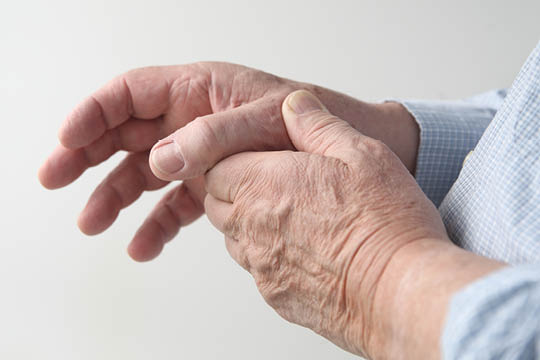Dupuytren’s disease causes thick lumps and cords to develop under the skin on the palm of the hand. Over time, these thickenings under the skin can pull the finger down into the palm, eventually leaving one or more fingers unable to straighten. These cords are made up of thickened connective tissue in the hand called palmar fascia.
--What are the symptoms of Dupuytren’s disease?
Symptoms include:
- a lump or nodule over the palm of the hand close to the base of the finger
- this condition most commonly affects the ring and little fingers, but can affect the other digits and thumb
- lumps can become a thicker cord running along the palm and into the fingers
- Dupuytren’s is usually painless
Dupuytren’s can progress over years to decades, and ultimately limit the ability to straighten the fingers or thumb away from the palm.
--What causes Dupuytren’s disease?
The cause of Dupuytren’s disease is unknown. A number of factors are believed to increase your risk of developing the disease, which include being an older man, having diabetes or the overuse alcohol and cigarettes. Dupuytren’s disease is also believed to run in families from Scandinavian heritage, which is why it’s also known as the Viking’s disease.
--How do I know if I have Dupuytren’s disease?
Dupuytren’s disease does have a characteristic look that is easily diagnosed by a GP or physiotherapist. The visible lumps or cords in the hand are identified as Dupuytren’s. You may be unable to flatten your hand on the table. It is rarely painful, but can affect your ability to use your hand due to difficulty straightening.
--How can physiotherapy help with Dupuytren’s?
Treatment for Dupuytren’s disease is mostly by surgery or injection. There is no physiotherapy treatment that has been found to be useful before surgery. The rule of thumb is that you would consider an injection or surgery when you are unable to place your hand flat on a table.
Physiotherapy is very important after surgery to soften scar tissue and restore movement, function and strength. You will often need to wear a custom-made hand splint to keep your fingers straight at night for several weeks to months after surgical treatment.
It’s important to note that not all physiotherapists are specialised in the area of hand therapy. For the best treatment outcome, find a physio who specialises in this area.
--How effective is physiotherapy for Dupuytren’s disease?
Physiotherapy is unable to straighten a finger bent by Dupuytren’s or change the progression of the contracture. After surgery, you will need physiotherapy to maximise the straightening of the finger, soften the scarring, and maintain the improvement in movement in the finger and the strength of the hand.
--What can I do at home?
There is little you can do for Dupuytren’s before surgery. It is best to monitor the condition as it can take many years or even decades for it to progress. When you are no longer able to place your hand flat on the table or you are having difficulty with daily activities, it is best to seek medical or surgical advice. Your hand surgeon will discuss the most appropriate surgery for your hands. It’s best not to try to force the fingers straight as this can aggravate the tissues and make the situation worse.
After surgery, it is important to see your physiotherapist for splinting and scar management to get the best result and maximise function.
--How long until I feel better?
Wounds will usually take around 10–14 days to heal. Moving the fingers gently is important during this time. You should be able to use your fingers for many day-to-day tasks after the first fortnight and there will be a gradual reduction in pain and swelling, and improvement in motion and strength for up to three months.
Early physiotherapy can help to prevent complications and minimise pain after surgery. Full recovery after surgery can take up to three months or longer depending on the position of the finger before surgery and what is required in surgery to straighten the finger.

